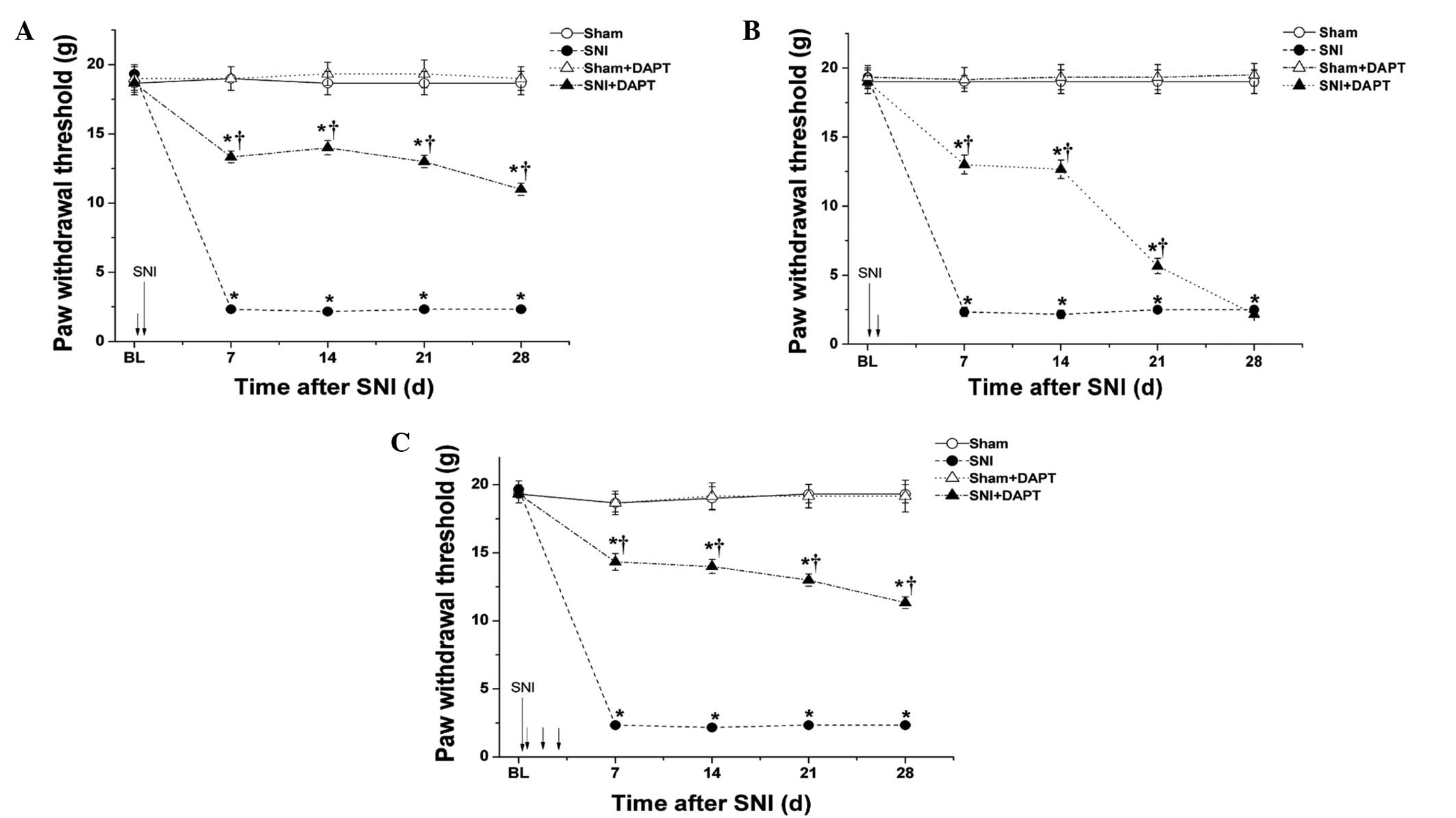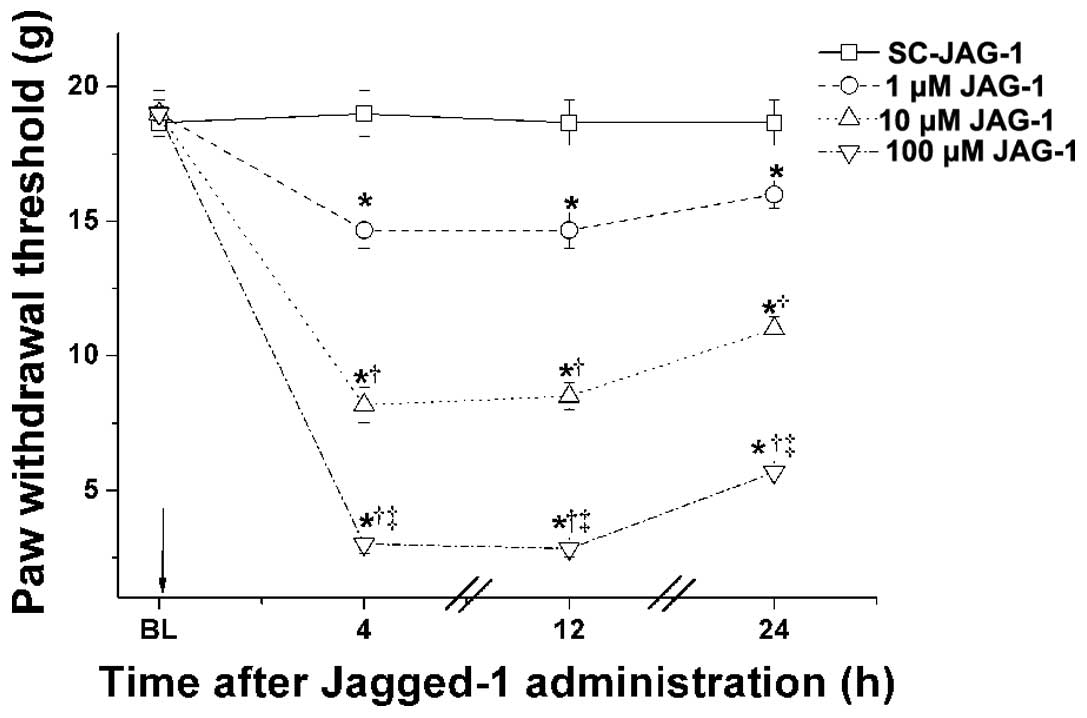|
1
|
Scholz J and Woolf CJ: The neuropathic
pain triad: neurons, immune cells and glia. Nat Neurosci.
10:1361–1368. 2007. View
Article : Google Scholar : PubMed/NCBI
|
|
2
|
Zimmermann M: Pathobiology of neuropathic
pain. Eur J Pharmacol. 429:23–37. 2001. View Article : Google Scholar : PubMed/NCBI
|
|
3
|
Willis WD: Role of neurotransmitters in
sensitization of pain responses. Ann N Y Acad Sci. 933:142–156.
2001. View Article : Google Scholar
|
|
4
|
Woolf CJ: Evidence for a central component
of post-injury pain hypersensitivity. Nature. 306:686–688. 1983.
View Article : Google Scholar : PubMed/NCBI
|
|
5
|
Moore KA, Kohno T, Karchewski LA, Scholz
J, Baba H and Woolf CJ: Partial peripheral nerve injury promotes a
selective loss of GABAergic inhibition in the superficial dorsal
horn of the spinal cord. J Neurosci. 22:6724–6731. 2002.PubMed/NCBI
|
|
6
|
Porreca F, Ossipov MH and Gebhart GF:
Chronic pain and medullary descending facilitation. Trends
Neurosci. 25:319–325. 2002. View Article : Google Scholar : PubMed/NCBI
|
|
7
|
Gillespie CS, Sherman DL, Fleetwood-Walker
SM, Cottrell DF, Tait S, Garry EM, Wallace VC, Ure J, Griffiths IR,
Smith A, et al: Peripheral demyelination and neuropathic pain
behavior in periaxin-deficient mice. Neuron. 26:523–531. 2000.
View Article : Google Scholar : PubMed/NCBI
|
|
8
|
Woolf CJ and Costigan M: Transcriptional
and posttranslational plasticity and the generation of inflammatory
pain. Proc Natl Acad Sci USA. 96:7723–7730. 1999. View Article : Google Scholar : PubMed/NCBI
|
|
9
|
Wood JN, Boorman JP, Okuse K and Baker MD:
Voltage-gated sodium channels and pain pathways. J Neurobiol.
61:55–71. 2004. View Article : Google Scholar : PubMed/NCBI
|
|
10
|
Yu XM and Salter MW: Src, a molecular
switch governing gain control of synaptic transmission mediated by
N-methyl-D-aspartate receptors. Proc Natl Acad Sci USA.
96:7697–7704. 1999. View Article : Google Scholar : PubMed/NCBI
|
|
11
|
Marchand F, Perretti M and McMahon SB:
Role of the immune system in chronic pain. Nat Rev Neurosci.
6:521–532. 2005. View
Article : Google Scholar : PubMed/NCBI
|
|
12
|
Scholz J, Broom DC, Youn DH, Mills CD,
Kohno T, Suter MR, Moore KA, Decosterd I, Coggeshall RE and Woolf
CJ: Blocking caspase activity prevents transsynaptic neuronal
apoptosis and the loss of inhibition in lamina II of the dorsal
horn after peripheral nerve injury. J Neurosci. 25:7317–7323. 2005.
View Article : Google Scholar : PubMed/NCBI
|
|
13
|
Baron R, Binder A and Wasner G:
Neuropathic pain: diagnosis, pathophysiological mechanisms and
treatment. Lancet Neurol. 9:807–819. 2010. View Article : Google Scholar : PubMed/NCBI
|
|
14
|
Louvi A and Artavanis-Tsakonas S: Notch
signalling in vertebrate neural development. Nat Rev Neurosci.
7:93–102. 2006. View
Article : Google Scholar : PubMed/NCBI
|
|
15
|
Latasa MJ, Cisneros E and Frade JM: Cell
cycle control of Notch signaling and the functional regionalization
of the neuroepithelium during vertebrate neurogenesis. Int J Dev
Biol. 53:895–908. 2009. View Article : Google Scholar : PubMed/NCBI
|
|
16
|
Costa RM, Drew C and Silva AJ: Notch to
remember. Trends Neurosci. 28:429–435. 2005. View Article : Google Scholar : PubMed/NCBI
|
|
17
|
Kopan R and Ilagan MX: The canonical Notch
signaling pathway: unfolding the activation mechanism. Cell.
137:216–233. 2009. View Article : Google Scholar : PubMed/NCBI
|
|
18
|
Fortini ME: Notch signaling: the core
pathway and its posttranslational regulation. Dev Cell. 16:633–647.
2009. View Article : Google Scholar : PubMed/NCBI
|
|
19
|
Woodhoo A, Alonso MB, Droggiti A, Turmaine
M, D’Antonio M, Parkinson DB, Wilton DK, Al-Shawi R, Simons P, Shen
J, et al: Notch controls embryonic Schwann cell differentiation,
postnatal myelination and adult plasticity. Nat Neurosci.
12:839–847. 2009. View
Article : Google Scholar : PubMed/NCBI
|
|
20
|
Gridley T: Notch signaling in vascular
development and physiology. Development. 134:2709–2718. 2007.
View Article : Google Scholar : PubMed/NCBI
|
|
21
|
Shih IeM and Wang TL: Notch signaling,
gamma-secretase inhibitors and cancer therapy. Cancer Res.
67:1879–1882. 2007. View Article : Google Scholar : PubMed/NCBI
|
|
22
|
Arumugam TV, Cheng YL, Choi Y, Choi YH,
Yang S, Yun YK, Park JS, Yang DK, Thundyil J, Gelderblom M, et al:
Evidence that {gamma}-secretase-mediated Notch signaling induces
neuronal cell death via the NF{kappa}B-Bim pathway in ischemic
stroke. Mol Pharmacol. 80:23–31. 2011. View Article : Google Scholar : PubMed/NCBI
|
|
23
|
Arumugam TV, Chan SL, Jo DG, Yilmaz G,
Tang SC, Cheng A, Gleichmann M, Okun E, Dixit VD, Chigurupati S, et
al: Gamma secretase-mediated Notch signaling worsens brain damage
and functional outcome in ischemic stroke. Nat Med. 12:621–623.
2006. View
Article : Google Scholar : PubMed/NCBI
|
|
24
|
Grandbarbe L, Michelucci A, Heurtaux T,
Hemmer K, Morga E and Heuschling P: Notch signaling modulates the
activation of microglial cells. Glia. 55:1519–1530. 2007.
View Article : Google Scholar : PubMed/NCBI
|
|
25
|
Yuan TM and Yu HM: Notch signaling: key
role in intrauterine infection/inflammation, embryonic development
and white matter damage? J Neurosci Res. 88:461–468. 2010.
|
|
26
|
Sestan N, Artavanis-Tsakonas S and Rakic
P: Contact-dependent inhibition of cortical neurite growth mediated
by notch signaling. Science. 286:741–746. 1999. View Article : Google Scholar : PubMed/NCBI
|
|
27
|
Jurynczyk M, Jurewicz A, Bielecki B, Raine
CS and Selmaj K: Overcoming failure to repair demyelination in EAE:
gamma-secretase inhibition of Notch signaling. J Neurol Sci.
265:5–11. 2008. View Article : Google Scholar
|
|
28
|
Morrison SJ, Perez SE, Qiao Z, Verdi JM,
Hicks C, Weinmaster G and Anderson DJ: Transient Notch activation
initiates an irreversible switch from neurogenesis to gliogenesis
by neural crest stem cells. Cell. 101:499–510. 2000. View Article : Google Scholar : PubMed/NCBI
|
|
29
|
Mizuguchi R, Kriks S, Cordes R, Gossler A,
Ma Q and Goulding M: Ascl1 and Gsh1/2 control inhibitory and
excitatory cell fate in spinal sensory interneurons. Nat Neurosci.
9:770–778. 2006. View
Article : Google Scholar : PubMed/NCBI
|
|
30
|
Givogri MI, de Planell M, Galbiati F,
Superchi D, Gritti A, Vescovi A, de Vellis J and Bongarzone ER:
Notch signaling in astrocytes and neuroblasts of the adult
subventricular zone in health and after cortical injury. Dev
Neurosci. 28:81–91. 2006. View Article : Google Scholar : PubMed/NCBI
|
|
31
|
Yan LH, Hou JF, Liu MG, Li MM, Cui XY, Lu
ZM, Zhang FK, An YY, Shi L and Chen J: Imbalance between excitatory
and inhibitory amino acids at spinal level is associated with
maintenance of persistent pain-related behaviors. Pharmacol Res.
59:290–299. 2009. View Article : Google Scholar : PubMed/NCBI
|
|
32
|
Jazayeri SB, Firouzi M, Abdollah Zadegan
S, Saeedi N, Pirouz E, Nategh M, Jahanzad I, Mohebbi Ashtiani A and
Rahimi-Movaghar V: The effect of timing of decompression on
neurologic recovery and histopathologic findings after spinal cord
compression in a rat model. Acta Med Iran. 51:431–437.
2013.PubMed/NCBI
|
|
33
|
Decosterd I and Woolf CJ: Spared nerve
injury: an animal model of persistent peripheral neuropathic pain.
Pain. 87:149–158. 2000. View Article : Google Scholar : PubMed/NCBI
|
|
34
|
Tegeder I, Costigan M, Griffin RS, Abele
A, Belfer I, Schmidt H, Ehnert C, Nejim J, Marian C, Scholz J, et
al: GTP cyclohydrolase and tetrahydrobiopterin regulate pain
sensitivity and persistence. Nat Med. 12:1269–1277. 2006.
View Article : Google Scholar : PubMed/NCBI
|
|
35
|
Woolf CJ, Shortland P and Coggeshall RE:
Peripheral nerve injury triggers central sprouting of myelinated
afferents. Nature. 355:75–78. 1992. View Article : Google Scholar : PubMed/NCBI
|
|
36
|
Fitzgerald M: The development of
nociceptive circuits. Nat Rev Neurosci. 6:507–520. 2005. View Article : Google Scholar : PubMed/NCBI
|













